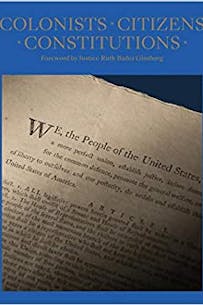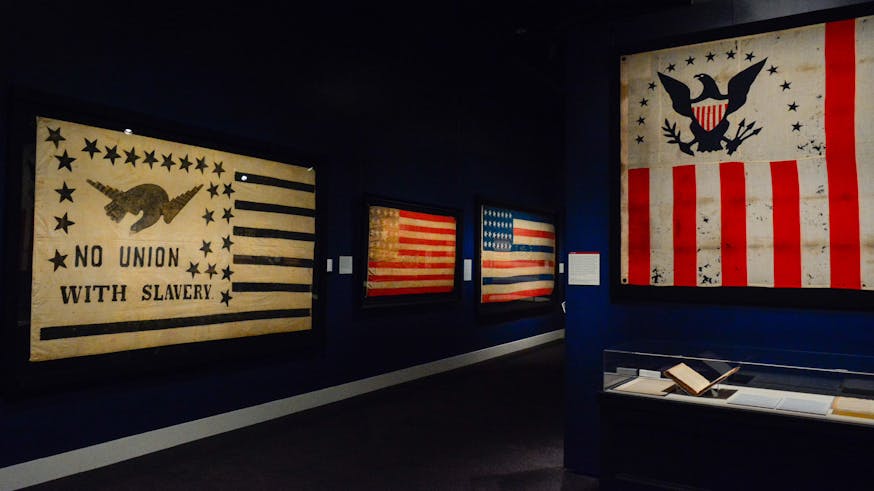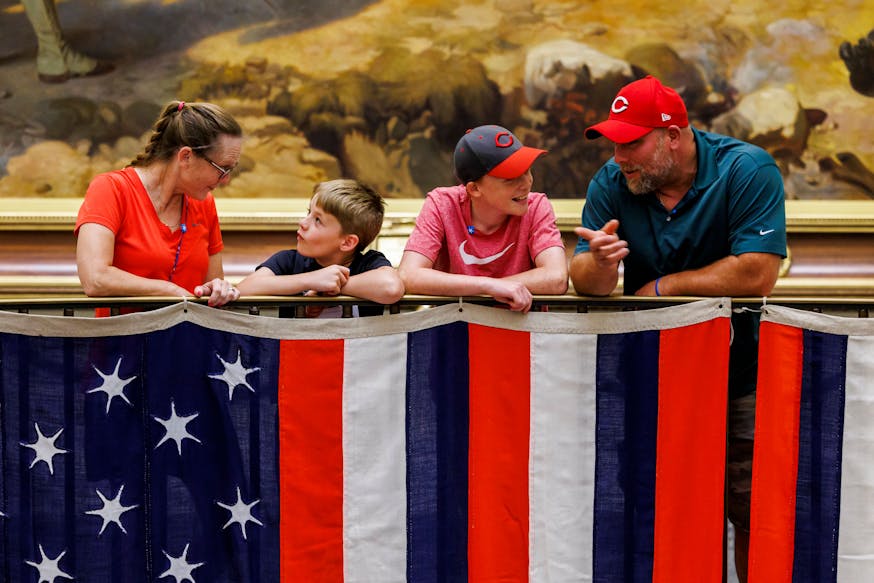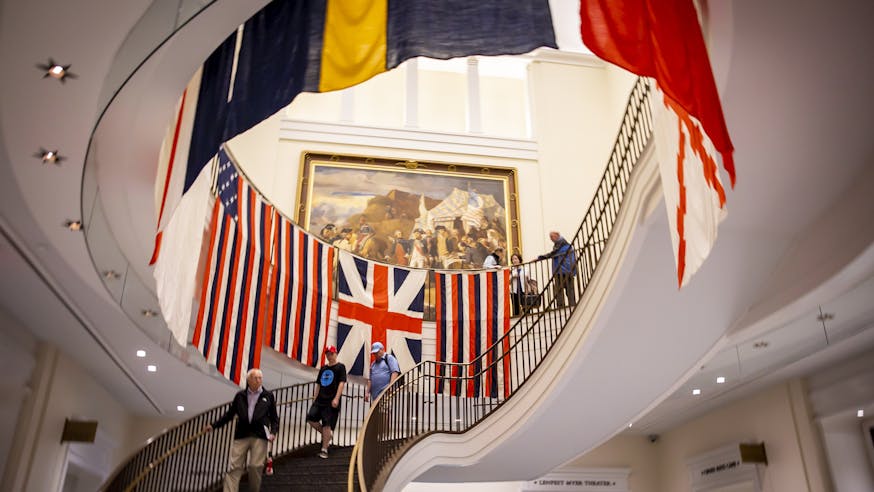Read the Revolution
Colonists, Citizens, Constitutions
June 9, 2021
Purchase the book from the Museum Shop.
In the illustrated book that accompanied the New-York Historical Society exhibition, Colonists, Citizens, Constitutions: Creating the American Republic, author and curator James F. Hrdlicka discusses 42 documents from the collection of the Dorothy Tapper Goldman Foundation. In context with Hrdlicka’s scholarship, these documents will be displayed as part of our summer 2021 exhibit, Flags and Founding Documents, 1776-Today, opening at the Museum on June 12.
Each document, written between 1732 and 1910, presents an opportunity to explore stories of how American colonists-turned-citizens created governments by the people in their state and federal constitutions. Organized chronologically with themes including experiments in self-government, an expanding Union, slavery and freedom, and reform and renewal, Hrdlicka argues that this collection’s “material existence — their nature as tactile objects produced, circulated, and preserved — remains crucial to understanding American democracy.”
Read from Hrdlicka’s introduction and about the most recent constitutions on display including an excerpt from the Arizona state constitution from 1910, which summarizes more modern constitutional issues that states have faced as they join the Union, and how it influenced New Mexico’s bilingual constitution in the same year.
Excerpt 1
Americans did not invent the notion of a “constitution.” From their English forebears they inherited the idea that certain fundamental laws underlay any social compact. Yet as long as these constitutional agreements remained largely unwritten—constellations of implicit assumptions rather than texts made up of explicit provisions—unproductive discord, abuses of power, or even violations of basic rights were liable to occur. And, what is more, when such arrangements were held to be the products of impersonal historical processes rather than the work of identifiable human actors, they often became resistant to beneficial changes favored by the very people from whom governments were supposed to derive their authority.
Americans’ distinctive contribution lay in their emphasis on creating written constitutions, discrete documents that spelled out –as clearly as possible—both the forms of government the people would consent to establish and all the inviolable rights citizens would enjoy. Printing these constitutions, along with many documents related to the transparent process of drafting and approving them, became essential. Citizens needed to feel these texts in their hands and read them for themselves of for others. In the course of their debates, Americans wanted to cross words out and pencil new phrases in. They wanted copies for their shelves and copies sent to the remotest settlements, all the better to strengthen the bonds between citizens in a common community. Having these texts at hand ensured that everyone would be able to hold the powerful to account and that groups of citizens would understand the steps they could take to effect necessary changes to the political system. When Americans rewrote their frames of government, or when their old copies of these documents simply wore out, they reprinted them.
American political theory, then, depended to a large extent on citizens’ inclination to make their constitutional handiwork a material reality. The documents belonging to the Dorothy Tapper Goldman Foundation pay homage to this revolutionary idea. As the illustrations here reveal, some of the collection’s objects remain in pristine condition, as though they just came off the press, ready for dissemination to parts near or far. Others show the wear and tear that accompanies age, heavy use, and multiple owners. Whatever their physical appearance—or, indeed, because of it—all merit display and should command our attention.
Sign Up!
Get biweekly Read the Revolution featured excerpts right to your inbox.
Excerpt 2
Citizen Initiative
Cat. 41. Arizona Constitution of 1910
As Americans campaigned for prohibition, woman’s suffrage, and a host of other reforms in the decades surrounding the turn of the twentieth century, many asked whether citizens ought to play an even more direct role in making laws and revising their constitutions. American traditionally chose representatives to sit in legislatures and write laws on their behalf. There were plenty of ways for citizens to communicate their views, and regular elections provided them the opportunity to express their preferences at the ballot box. In many cases, however, citizens found that their elected officials were unresponsive and refused to enact the will of the people. Perhaps more troubling still, citizens could not exercise their sovereign authority to revise their constitutions without the help of their legislatures, which needed either to approve amendments or initiate the process of calling a convention. Many Americans blamed special interests—in the form of powerful corporations, usually—for corrupting the political process and blocking necessary reforms. Whether the source of the problem lay with special interests or simply in the conservative inertia that often characterizes democratic institutions, increasing numbers of citizens wanted a way to bypass their representatives and initiate laws and constitutional amendments themselves.
By the time delegates gathered in Phoenix to write Arizona’s first constitution in October 1910, several other states had already begun to experiment with new ways for citizens to effect democratic change. Arizonans wanted a frame of government in step with their growing, dynamic society. The territory had originally been acquired by the United States following the war with Mexico. After rising slowly for several decades, Arizona’s population increased fivefold between 1890 and 1910, surpassing 200,000. The long wait for statehood allowed Arizona’s first constitution-makers to profit from the experiences and models provided by Americans elsewhere.
Borrowing from several recent state constitutions, Article IV of the Arizona constitution outlined procedures for the “initiative” and the “referendum.” The initiative gave citizens the right to propose their own laws and constitutional amendments. First, citizens had to persuade qualified voters to sign a petition with “the title and text of the measure” being proposed. If citizens wanted to propose a law, they needed a number of signatures equivalent to 10 percent of the votes cast for all candidates for governor at the last election. If they wanted to propose a constitutional amendment, the number of required signatures rose to 15 percent of the same total. Though not trivial by any means, these requirements lay well within the capacities of motivated citizens, provided their cause enjoyed a baseline degree of support. Once a proposal earned enough signatures within the specified timeframe, the secretary of state arranged for it to be put on the ballot at the next election. If a majority of voters approved the measure, it became law or part of the constitution. Neither the legislature nor the governor had the power to block the process at any point.
In contrast, the referendum gave citizens the chance to block acts of the legislature. If 5 percent of qualified voters (calculated using the same method as in the initiative) objected to “any measure, or item, section, or part of any measure, enacted by the Legislature,” they could file a petition within ninety days of the legislature’s adjournment to put the question to a majority vote of the people at the next election. The constitution even stipulated that, in order to give citizens time to compose and file their referendum petitions, nonemergency acts of the legislature would become “operative” only after the ninety-day window expired. The constitution provided for initiative and referendum procedures at the local level as well.
Arizonans wasted little time putting the initiative to use. They ratified their constitution twice in 1911: first in February and then again, in a revise version, that December after President William Howard Taft objected to the constitution’s provisions allowing citizens to “recall” elected officials upon the petition of 25 percent of eligible voters. Arizonans removed the offending section long enough for Congress and the president to grant them statehood on February 14, 1912.
[…]
Workers’ Rights
Cat. 42 Bilingual New Mexico Constitution of 1910
Although New Mexico’s convention coincided with Arizona’s, the constitutions produced by the neighboring states differed on several points. The delegates who gathered in Santa Fe in late 1910 adopted a referendum provision but declined to approve the citizen initiative for proposing laws and amendments. In fact, the constitution New Mexico voters ratified in January 1911 made amendment too difficult in the eyes of Congress, which asked the state to lower the legislative majority needed to refer constitutional revisions to voters. Citizens complied, and New Mexico entered the union in January 1912. Even though they rejected some of the Progressive era's constitutional innovations, New Mexico's citizens embraced several others, notably in the area of workers’ rights.
New Mexico's path to joining the union stretched back to 1850, when Congress rejected an early statehood petition for fear of exacerbating the sectional crisis over slavery. In the half century that followed, the number of New Mexico's inhabitants was never the issue; the territory more than met the conventional population threshold for statehood. The obstacle lay in the citizenry's composition. The majority of new Mexicans were of Hispanic heritage, and many white Americans hesitated to incorporate a population of this ethnic, religious, and linguistic background. Elements of the Hispano majority, in turn, worried that statehood might mean greater political and cultural suppression. In 1906, a plan to combine New Mexico and Arizona into one state failed when Arizonans rejected the idea (despite New Mexico's endorsement). By 1910, all parties agreed on separate statehood and constitution-making commenced. Hispanos held about one-third of the one hundred seats in the Santa Fe convention, enough to guarantee that all laws—including the constitution—would be published in both English and Spanish for at least twenty years. Spanish-speaking citizens would enjoy other protections as well.
Several provisions of the New Mexico constitution aimed to soften the adverse consequences of a modern economy. The emergence of the United States as a global industrial powerhouse in the period following the Civil War had altered the working conditions experienced by many Americans. Western states such as New Mexico were home to several especially hazardous industries. To their credit, delegates wanted to provide basic safeguards for some of the state’s most vulnerable working-class citizens. Because an unfortunate number of young children numbered among this group, the constitution urged the legislature to enact “suitable laws for the regulation of” their employment. A more specific provision concerned employer liability. All railroad corporations, the constitution declared, would have to pay damages to any employee who suffered injury or death as a result of the company’s “negligence,” and the corporations were also prohibited from making their workers sign contracts “waiving or limiting [their] right to recover damages.” Other provisions forbade the state from leasing out the labor of its convicts, and mandated an eight-hour workday for all individuals employed by the state, country, or municipality.
In adopting these and other measures, Americans yet again exercised their power to determine the character of the governments under which they lived. Without question, the protections that late nineteenth- and early twentieth-century state constitutions offered to workers can appear paltry and insufficient to modern eyes. North Dakota’s 1889 constitution, for instance, declared that “the labor of children under twelve years of age shall be prohibited in mines, factories, and workshops in this state.” These provisions did, nevertheless, point toward the society that many citizens aspired to create. They also inspired future generations as they, too, responded to the rapid changes that have been a constant feature of American life. The minimum wage provision that Ohioans added to their constitution in 1912 may have seemed a novelty at first, but it eventually gained admirers and emulators around the country. Soon, Americans extended the debate over workers’ rights to include collective bargaining and the right to organize.
James F. Hrdlicka, Colonists, Citizens and Constitutions: Creating the American Republic (Scala Arts Publishers, Inc., 2020), 18-19 and 185, 188-189.
Read the Revolution is sponsored by The Haverford Trust Company.
Read the Revolution is published biweekly by the Museum of the American Revolution to inspire learning about the history of the American Revolution and its ongoing relevance.
Tags
Learn More

Flags and Founding Documents, 1776-Today
June 12 - September 6, 2021
A Revolutionary Summer


